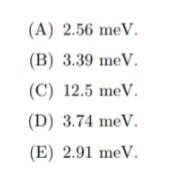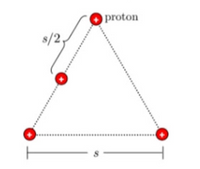
College Physics
11th Edition
ISBN: 9781305952300
Author: Raymond A. Serway, Chris Vuille
Publisher: Cengage Learning
expand_more
expand_more
format_list_bulleted
Concept explainers
Question
Three protons are each located at the corners of an equilateral triangle as shown. One other proton is located in the middle of two charges. If s=3.46 um, the total electric potential energy of the system of protons relative to infinity is most nearly?

Transcribed Image Text:(A) 2.56 meV.
(B) 3.39 meV.
(C) 12.5 meV.
(D) 3.74 meV.
(E) 2.91 meV.

Transcribed Image Text:proton
s/2,
Expert Solution
This question has been solved!
Explore an expertly crafted, step-by-step solution for a thorough understanding of key concepts.
This is a popular solution
Trending nowThis is a popular solution!
Step by stepSolved in 2 steps with 2 images

Knowledge Booster
Learn more about
Need a deep-dive on the concept behind this application? Look no further. Learn more about this topic, physics and related others by exploring similar questions and additional content below.Similar questions
- An ion, starting from rest, accelerates from point A to point B due to a potential difference between the two points. Does the electric potential energy of the ion at point B depend on (a) the magnitude of its charge and (b) its mass? Does the speed of the ion at B depend on (c) the magnitude of its charge and (d) its mass?arrow_forwardI have a question regarding two charges on an axis. The problem is as follows: Two particles each with charge +1.79 µC are located on the x axis. One is at x = 1.00 m, and the other is at x = −1.00 m. (a) Determine the electric potential on the y axis at y = 0.520 m. (b) Calculate the change in electric potential energy of the system as a third charged particle of -3.81 µC is brought from infinitely far away to a position on the y axis at y = 0.520 m.arrow_forwardTwo point charges Q1 = -2.00 nC and Q: = +4.00 nC are separated by 40.0 cm. (a) What is the potential energy of the pair? (b) What is the electric potential at a point midway between the charges?arrow_forward
- Consider two charged particles. One charge located on the y-axis has a value -2q and is located at a distance r from the origin, point O. The other charge has a value -q and is located at a distance 2r from the origin along the x-axis. The electric potential energy of this system is equal to 0.9 kg² r -0.6- 0.3. 0.6- kq² kq² r kq² -0.9. r kq²arrow_forwardThree charged particles are located on x-axis. Particle 1 carries charge +2 nC, located at x = -3 cm; particle 2 carries charge -3 nC, located at x = 1 cm; particle 3 carries charge +1 nC, located at x = 5 cm. Calculate the electric potential energy of particle 3. Answer should be in Joulesarrow_forwardFind the total electric potential energy QC has due to QA & QB.arrow_forward
- Ch 19, problem 16 The drawing shows a square, each side of which has a length of L = 0.250 m. Two different positive charges q1 and q2 are fixed at the corners of the square. Find the electric potential energy of a third charge q3 = -7.00 x 10-9 C placed at corner A and then at corner B.arrow_forwardThree equal point charges, each with charge 1.40 μC , are placed at the vertices of an equilateral triangle whose sides are of length 0.600 mm . What is the electric potential energy U of the system? (Take as zero the potential energy of the three charges when they are infinitely far apart.)arrow_forwardThe drawing shows a square, each side of which has a length of L= 0.250 m. Two different positive charges q1 and q2 are fixed at the corners of the square. Find the electric potential energy of a third charge q3 = -6.00 x 10°C placed at corner A and %3D then at corner B. 41 = +1.50 x 10c 92= +4.00 x 10 carrow_forward
- Two point charges Q1= -2.00 nC and Q2= +4.00 nC are separated by 40.0 cm. (a) What is the potential energy of the pair? (b) What is the electric potential at a point midway between the charges?arrow_forwardTwo point charges, Q = +5.60 μC and q = −2.10 μC, are separated by 5.0 m. What is the electric potential energy?arrow_forwardTwo positive point charges are 1.90 cm apart. If the electric potential energy is 69.2 μJ, what is the magnitude of the force (in mN) between the two charges?arrow_forward
arrow_back_ios
SEE MORE QUESTIONS
arrow_forward_ios
Recommended textbooks for you
 College PhysicsPhysicsISBN:9781305952300Author:Raymond A. Serway, Chris VuillePublisher:Cengage Learning
College PhysicsPhysicsISBN:9781305952300Author:Raymond A. Serway, Chris VuillePublisher:Cengage Learning University Physics (14th Edition)PhysicsISBN:9780133969290Author:Hugh D. Young, Roger A. FreedmanPublisher:PEARSON
University Physics (14th Edition)PhysicsISBN:9780133969290Author:Hugh D. Young, Roger A. FreedmanPublisher:PEARSON Introduction To Quantum MechanicsPhysicsISBN:9781107189638Author:Griffiths, David J., Schroeter, Darrell F.Publisher:Cambridge University Press
Introduction To Quantum MechanicsPhysicsISBN:9781107189638Author:Griffiths, David J., Schroeter, Darrell F.Publisher:Cambridge University Press Physics for Scientists and EngineersPhysicsISBN:9781337553278Author:Raymond A. Serway, John W. JewettPublisher:Cengage Learning
Physics for Scientists and EngineersPhysicsISBN:9781337553278Author:Raymond A. Serway, John W. JewettPublisher:Cengage Learning Lecture- Tutorials for Introductory AstronomyPhysicsISBN:9780321820464Author:Edward E. Prather, Tim P. Slater, Jeff P. Adams, Gina BrissendenPublisher:Addison-Wesley
Lecture- Tutorials for Introductory AstronomyPhysicsISBN:9780321820464Author:Edward E. Prather, Tim P. Slater, Jeff P. Adams, Gina BrissendenPublisher:Addison-Wesley College Physics: A Strategic Approach (4th Editio...PhysicsISBN:9780134609034Author:Randall D. Knight (Professor Emeritus), Brian Jones, Stuart FieldPublisher:PEARSON
College Physics: A Strategic Approach (4th Editio...PhysicsISBN:9780134609034Author:Randall D. Knight (Professor Emeritus), Brian Jones, Stuart FieldPublisher:PEARSON

College Physics
Physics
ISBN:9781305952300
Author:Raymond A. Serway, Chris Vuille
Publisher:Cengage Learning

University Physics (14th Edition)
Physics
ISBN:9780133969290
Author:Hugh D. Young, Roger A. Freedman
Publisher:PEARSON

Introduction To Quantum Mechanics
Physics
ISBN:9781107189638
Author:Griffiths, David J., Schroeter, Darrell F.
Publisher:Cambridge University Press

Physics for Scientists and Engineers
Physics
ISBN:9781337553278
Author:Raymond A. Serway, John W. Jewett
Publisher:Cengage Learning

Lecture- Tutorials for Introductory Astronomy
Physics
ISBN:9780321820464
Author:Edward E. Prather, Tim P. Slater, Jeff P. Adams, Gina Brissenden
Publisher:Addison-Wesley

College Physics: A Strategic Approach (4th Editio...
Physics
ISBN:9780134609034
Author:Randall D. Knight (Professor Emeritus), Brian Jones, Stuart Field
Publisher:PEARSON